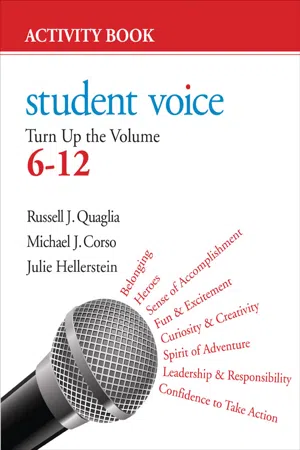
Student Voice
Turn Up the Volume 6-12 Activity Book
- 160 pages
- English
- ePUB (mobile friendly)
- Available on iOS & Android
Student Voice
Turn Up the Volume 6-12 Activity Book
About this book
Promote student self worth and engagement with these one-of-a-kind activities!
Help your students reach their fullest potential. Create unique learning experiences adaptable to their needs and aspirations with this extraordinary activity book from internationally acclaimed experts Dr. Russell Quaglia, Michael Corso and Julie Hellerstein. A companion piece to Quaglia's K-8 guide, the authors implement 3 Guiding Principles and 8 Behaviors and Conditions that profoundly affect student success in grades 6 - 12.
You'll discover student-centric ideas and activities that powerfully engage 6th-12th grade students in important content areas. Timesaving and easy-to-implement activities help you to:
- Promote student self expression, values, hopes and dreams
- Foster student engagement, sense of purpose and self worth
- Provide a creative and challenging learning environment for all ability levels
- Align activities with Common Core and ISTE Standards (NETS) and 21st Century Skills
- Promote student leadership and responsibility
- Capitalize on technology and promote interdisciplinary connections
Includes a handy correlation chart and group discussions, personal reflections, and extended learning opportunities for each stand-alone lesson. An inspiring resource for any educator, use these fun, extensively researched activities to help your students reach their full potential!
The authors have once again designed an extraordinary roadmap for teachers to use in guiding students to find their true voice. A research-based roadmap yes, but more importantly, a map teachers can use to guide students to find their voice through their experiences. The wonderful activities herein are inspiring, engaging and interactive and ultimately lead students to discover their own unique voice and aspirations!"
Rich McBride, Ed.D., Superintendent
2014 AESA National President
Frequently asked questions
- Essential is ideal for learners and professionals who enjoy exploring a wide range of subjects. Access the Essential Library with 800,000+ trusted titles and best-sellers across business, personal growth, and the humanities. Includes unlimited reading time and Standard Read Aloud voice.
- Complete: Perfect for advanced learners and researchers needing full, unrestricted access. Unlock 1.4M+ books across hundreds of subjects, including academic and specialized titles. The Complete Plan also includes advanced features like Premium Read Aloud and Research Assistant.
Please note we cannot support devices running on iOS 13 and Android 7 or earlier. Learn more about using the app.
Information
Chapter 1 Belonging
Grades 9–12: Belonging Activities
Aspirations Story Squares: (about 50 minutes)
Belonging:
Common Core:
21st Century Skills:
ISTE/NETS:
Objective:
Steps:
- Provide each student with a graphic organizer.
- Have students form a circle.
- Instruct students to draw or write in each section based on the following questions listed on the graphic organizer:
- Draw or write about something that makes you special or unique.
- Draw a picture or write the name of someone who is there for you when you need them.
- Draw a picture of something you are proud of other than your grades.
- Draw a picture or briefly describe how you learn best.
- Write down a question that you would like to know the answer to.
- Write down something you would like to try, but you are not sure if you will be good at it.
- Draw a picture of yourself as a leader.
- Write down something you would like to do in the future and how you could start achieving this goal today.

- Assign each person a partner and have each share his or her Aspirations Story Squares for one minute.
- Pair students into boy/girl partners.
- Ask the students to focus on listening to each other.
- Next, have students select a new partner and share for one minute each.
- After they have shared with a second partner, have everyone return into to the circle as a whole group.
- Ask each person to share one item from another student’s Aspirations Story Squares that they found interesting.
- Invite students to pick a square to develop into a narrative.
Personal Reflection:
Group Reflection:
- What did you learn about your classmates? How did they make their story meaningful to you?
- How does knowing your classmates’ stories benefit our class as a whole?
- Why is it important to interact with all different types of students?
- Why is it important for your teachers to know you as an individual? How could this help you be successful?
- What was it like to share your story squares? What details are necessary to explain to someone when creating a narrative?
- What will help orient or engage your audience to your narrative?
Extended Learning:
Table of contents
- Cover
- Acknowledgements
- Title Page
- Copyright Page
- Contents
- Acknowledgements
- Preface: No Ordinary Activity Book
- Acknowledgments
- About the Authors
- Chapter 1 Belonging
- Chapter 2 Heroes
- Chapter 3 Sense of Accomplishment
- Chapter 4 Fun & Excitement
- Chapter 5 Curiosity & Creativity
- Chapter 6 Spirit of Adventure
- Chapter 7 Leadership & Responsibility
- Chapter 8 Confidence to Take Action
- Appendix A Common Core State Standards, Grades 6–12
- Appendix B Partnership for 21st Century Skills, Grades 6–12
- Appendix C ISTE Standards, Grades 6–12
- Index
- Publisher Note